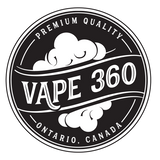What is eJuice? A Beginners Guide


eLiquid or eJuice is the fluid that drives vaping. For many vapers, it’s the vessel which provides nicotine and flavour without combustable tobacco. If you’re new to vaping, chances are you feel overwhelmed with the variety and terminology surrounding eJuice. Don’t fret, we will clarify everything.
Let’s get into it.
The names for eJuice come in many forms, which all refer to the same thing. eJuice, eLiquid, and Vape Juice all refer to the same thing - the bottle of liquid you use to vape.
eJuice is generally composed of 3-4 ingredients – PG, VG, flavourings, and if you choose, nicotine. You will see this terminology on every vaping website, so let’s decipher what they are and why it's in your eJuice.

Used as a base to hold nicotine and flavour, Propylene Glycol, or PG, is commonly used in foods to transport flavour. PG is considered non-toxic and is often found in your everyday foods and medicines, including asthma inhalers, baby wipes, shampoos, pet food, and many other daily items. Approved by Health Canada, PG is widely used without concern. There are some people who possess an allergy to Propylene Glycol (PG), which is likely to be known due to the large amount of products containing this ingredient. In cases where people have an allergy or sensitivity to PG, Vegetable Glycerin (VG) can be used as their base for transferring nicotine or flavourings in their eLiquid or eJuice.

Getting its name from being a vegetable based liquid, Vegetable Glycerin, or VG, is also a non-toxic ingredient that’s known for being smooth, sweet, and thick. VG is used in eJuice due to its non-toxic properties, sweetness, and its ability to remove the harshness that comes with PG. Since VG is so thick, using a base that is 100% VG is difficult to vaporize efficiently. If an allergy or sensitivity to PG is not a factor for you, we recommend using a combination of PG & VG in your vape juice. The ratio of PG/VG can often be found on the bottle, or displayed in the product description when buying online.
PG and VG are generally considered “safe for human consumption”, which is why it’s found in thousands of every day foods and items. Apart from allergic reactions, recent studies show that PG and VG are generally considered “safe.” As we all know, long term studies have not been concluded, however, the short term studies are proving to be very optimistic.

When mixing eJuice, ISO certified labs have four options to choose from when it comes to adding flavour. Similar to food flavourings, the choices are natural flavouring, artificial flavouring, flavourless, or a mixture of both natural and artificial flavouring.
Natural flavouring that’s used in eJuice contains no artificial ingredients, colours, sweeteners, or additives. Just like in foods, natural flavouring is achieved by extracting the flavour from its natural source to make a concentrate. At this point, the concentrate is sold to a certified manufacturer, where it’s mixed into the eJuice, bottled, and shipped.
Artificial flavouring is a chemical mixture that’s developed to imitate the natural flavour of a product. Found often in foods we consume, artificial flavouring is popular due to the lower cost and manufacturing times required to develop a flavour. We’re looking at you, cigar flavours.
A Natural and Artificial Flavouring blend is commonly used when creating eJuice flavours. For example, if a company manufactures an apple tobacco flavour, they may use artificial flavouring to achieve the apple taste, while using real tobacco leaves to extract the tobacco flavour in the eLiquid.
Flavourless vape juices are flavours that contain no added flavourings – it will just consist of the base ingredients, PG & VG (Propylene Glycol & Vegetable Glycerin). Flavourless eJuices are much more popular than most people would assume, but are still the least popular in terms of demand.

The optional fourth ingredient is nicotine. Nicotine in eJuice is delivered in two forms, freebase nicotine and nicotine salts. There’s limited data on the health effects of long-term use of pure nicotine, because nicotine is historically consumed through tobacco products. The effects of nicotine on your health when it’s delivered through vaping is yet to be determined. Since nicotine is predominantly used in traditional cigarettes and tobacco products, Governments and anti-vaping groups use the inclusion of nicotine in vaping as a way to classify vaping as a tobacco product.
As mentioned above, nicotine is an optional ingredient in you vape juice. Each bottle of eJuice will contain a milligram (mg) content of nicotine. The “mg” level displayed on every bottle of eLiquid lets vapers know the exact amount of nicotine present per milliliter (mL) of eLiquid. For example, if you purchase a 60mL bottle of eLiquid that contains 3mg of nicotine, this means that every 1mL of eLiquid contains 3mg of nicotine.
Freebase Nicotine is the standard nicotine choice used when manufacturing eLiquid and eJuice . By itself, nicotine wouldn’t be very potent in the body because it’s a base. Without getting too scientific, nicotine needs to be manipulated in order for your body and brain to effectively absorb it. This is done by adjusting the pH levels in base nicotine, creating a more potent form of nicotine called Freebase Nicotine. Freebase Nicotine is able to move much quicker across human membranes, giving users the nicotine fix they crave, almost instantly. Freebase nicotine is widely used in vaping and traditional tobacco as the standard delivery form of nicotine.
When choosing the level of Freebase Nicotine in your eLiquid, the standard options are:
- 0mg: No nicotine
- 3mg: Light Nicotine
- 6mg: Medium/Strong Nicotine
- 12mg: Strong/Very Strong Nicotine
Nicotine Salts are generally new to the market, but came in with a bang. If you haven’t heard of Nicotine Salts before, don’t feel out of the loop, it’s still only used in small numbers of eLiquid and eJuice as of today. Nicotine Salt is the natural form of nicotine as it’s found in tobacco leaves. Unlike Freebase Nicotine, Nicotine Salts aren’t just nicotine, they contain other organic compounds found in tobacco leaves. In freebase nicotine, the pH levels are increased to deliver a harsher hit, but in nicotine salts, benzoic acid is added for the opposite effect. Lowering the pH levels in nicotine reduces the harshness, allowing vapers a much smoother vape. Using nicotine salts allows eLiquid and eJuice to be vaped at much lower temperatures with a much higher concentration of nicotine. Mixing eLiquid with nicotine salts will be less potent, but vapers can now reach levels up to 50mg to reduce the amount of eLiquid vaped – saving vapers money on eJuice and high wattage devices.
When choosing nicotine salts, vapers should always keep in mind that it’s designed for lower wattage devices. We highly recommend avoiding sub-ohm devices with nicotine salts, as you will be receiving excessive amounts of nicotine that will become very unpleasant.
When choosing the level of Nicotine Salts in your eLiquid, the standard options are:
- 12mg: Light
- 20mg: Medium
- 45mg: Strong
That’s it. That’s what your eLiquid or eJuice consists of. Although fairly new, eLiquid is showing great promise in short term studies. We’re seeing traditional smokers kick their tobacco habits in large numbers, for what we hope to be a harm reduction alternative. We feel better, smell better, and are excited to see the potential of saving lives unfold right before our eyes.






Leave a comment